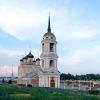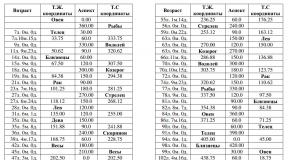Assumption Admiralty Church. Voronezh
The full name of the church is the Assumption of the Blessed Virgin Mary and the Ever-Virgin Mary. The riverine church is one of the most ancient and most remarkable religious buildings in the region in terms of its historical destiny. The exact time of its foundation has not been established; in any case, it happened in the first decade of the existence of the Voronezh fortress. Recently, publications by V.N. Glazyev and N.A. Komolov made it possible to clarify and “ancientize” the time of construction of the wooden Assumption Church. In a letter from Tsar Fyodor Ivanovich to voivode Ivan Kobyakov dated August 5, 1594, it was reported that the builder Alexander was sent to Voronezh. He brought from Moscow “to the church for the Dormition” with the chapel of Theodore Stratelates a variety of church utensils - icons, bells, liturgical books. All the utensils were purchased “in Voronezh” for the Assumption Monastery. As a builder, “he will bring images and books and bells,” said the royal letter to the governor, “and you would order the builder Oleksandr to place the images and books and bells at the Dormition of the Most Pure Mother of God and order him to build a monastery.” Both researchers conclude that the monastery was not built at that moment, but the Assumption Church, apparently, existed at that moment as a parish church. The Assumption Monastery arose “around 1600 with the installation of Tsar Boris” (Godunov), its founder is Abbot Kirill. It can be assumed that the riverside church was included in its composition. All monastic buildings at that time were wooden. Hollow water periodically flooded the floodplain, because of this the cells and the temple rotted. A particularly severe spill occurred in 1616. In the Assumption Church this year the chapel of Theodore Stratilates was mentioned. According to the Census Book of 1678, the Assumption Monastery was located in the same place, the main church was dedicated to the Ascension of the Lord “and within the Assumption of the Most Holy Theotokos, and Boris and Gleb.” At the end of the 17th century, the abbot of the monastery, Titus, decided to erect a stone, two-light, five-domed temple instead of the old wooden one. This temple was designed for approximately five hundred people and was conceived in the form of a tetrahedral pillar. The bell tower was planned to be low, in one tier, and should have been adjacent directly to the temple part, without a refectory. A church historian from the end of the last century, Archimandrite Dimitri (Sambikin), suggested that in these years the position of the Assumption Church “elevated to the level of the main cathedral in Voronezh,” since the church was built with five domes, and this in the old days served as a sign of the primacy of the cathedral in the city.
E.A. Bolkhovitinov and after him Archimandrite Dimitri point to December 27, 1699. The priest of the church and the author of an essay about it in “Voronezh Antiquity” (1906), Theodore Lukin, moves this event forward five years, to December 27, 1694. This dating aroused greater preference among local historians and was included in official publications about the historical and architectural monuments of Voronezh. But both 1694 and 1699, as the time of completion of the construction of the stone Assumption Church, conflict with other documents. In the autumn of 1694, a drawing of the area adjacent to the monastery was drawn up (the reason was a dispute over the ownership of a mill on one of the river channels). The drawing of the monk-cartographer was preserved in one of the Moscow archives and published in the book of the historian V.P. Zagorovsky “Voronezh: Historical Chronicle” (1989). In this picture the church appears wooden and three-domed. This does not seem to contradict the accepted dating, since the drawing dates back to the autumn of 1694. But the Assumption Church looked exactly the same in February 1703 - wooden, three-domed. An expert in Voronezh architecture, former director of the Museum of Local Lore A.P. Soloviev takes a different point of view. From the observation position occupied by the Dutchman, only three of the five domes of the church will be visible, while the other two are obscured in the projection. And secondly, he believes: the Assumption in the engraving is still made of stone, not wood: obviously wooden buildings are shaded differently. However, I am closer to V.P.’s point of view. Zagorovsky that the Assumption Church was rebuilt in stone immediately after 1703. In this case, its five-domed structure becomes clearer: at the beginning of the 18th century, it really acquired the status of the main Voronezh temple. One way or another, it is still the oldest stone structure in the city and is second only to the church of the Alekseevsky Akatov Monastery, built in 1674.
In the architecture of the Assumption Church, experts (N.V. Valukinsky, G.K. Lukomsky, Yu.I. Uspensky) noted the influence of medieval architecture of Rus'; it is clearly manifested in the high square nave, crowned with five domes. This is the oldest part of the church, for there was no refectory and bell tower in their present form then. The Assumption Church attracts attention not only with its ancient architecture. The point is also that this is the only surviving monument associated with shipbuilding in Voronezh at the end of the 17th - beginning of the 18th century. Peter I, who first came to our city in February 1696, found here the most convenient place to create a navy. In a short time, a German settlement grew up near the Assumption Monastery, and an admiralty was erected on the island, which included a citadel (fortress), a stone workshop, and a “sailing yard.” The king's palace and the houses of his associates A.D. were built nearby. Menshikova, F.M. Apraksina, F.A. Golovina, N.M. Zotova. On both sides of the monastery there was a shipyard. After the service in the Assumption Church on April 2, 1696, the first ship was launched - the galley "Principium", and a little later - the multi-gun ship "Apostle Peter". The fleet built in Voronezh enabled the Russian army to take the Turkish fortress of Azov on July 19, 1696. In 1700, according to the drawings of the tsar himself, the ship “Predestination” was built, in 1703 - “Light Iron”, “St. George”, “St. Natalia”. In 1704, the multi-gun galleasses “Dolphin”, “Vingelgak”, “Voronezh” were on the roadstead against the city; “Lastka” was being built on the slipways; “Old Eagle”, “Sleeping Lion”, “Samson”, “Sword” were pulled ashore. The monastery, which found itself at the epicenter of turbulent events, interfered with the shipyard; in 1700 it was abolished by Peter I and merged with Alekseevsky Akatov. The Assumption Church turned into the Admiralty Church. The construction of the fleet lasted until 1711. Only the Assumption Church remained a witness to those glorious events: part of the remaining buildings burned down in the fire of 1748, part was destroyed by time and the negligence of our ancestors. With the cessation of shipbuilding work, the Assumption Church became an ordinary parish church. Moreover, after the disaster of 1748, the parish became one of the poorest in Voronezh, because wealthy citizens began to move from the river to the upper plateau. Although it was in the Assumption parish at the end of the 17th century that the merchant Peter Gardenin (1756) built the first residential stone house in the city.
By the beginning of the 19th century, the welfare of the church had improved somewhat. In 1803, a three-tier bell tower was built, connected together with the temple part, and the “church was enlarged” (perhaps this means the appearance of a refectory with two side altars - in honor of the Epiphany of the Lord and in the name of St. Anthony and Theodosius of Pechersk). In 1880-1881, a new renovation followed: the entire church was “remodeled,” the windows of the first tier were increased in size, the porch at the northern entrance was demolished, a stone fence was built on the river side instead of an earthen rampart, and a guardhouse was added to the bell tower. The iconostasis of the temple was rewritten. On the night of June 6, 1885, the church was robbed: thieves sawed out the bars, tore off the vestments from the icons, stole sacred vessels and a golden cross donated by Peter I. In 1805, Archpriest Athenogenes of Pechersk, Deacon Theodore Chekalin, a sexton and a sexton served in the church. The parish consisted of 193 houses, where 1098 people of both sexes lived. At that time, near the church there was a stone house for the clergy, built in 1873. In 1894, an almshouse appeared, founded with funds from the merchant E.V. Gardenina, half of the building was occupied by a literacy school for girls. Among the attractions at the beginning of the last century in Uspenka were handwritten notes of ancient sacred music, a consecration cross found during renovation, and a high-backed chair upholstered in black morocco, made, according to legend, by Peter the Great himself. The parishioners supported the clergy - priest, deacon, psalm-reader, and maintained the dignified appearance of the temple. To be fair, it must be said that in 1911, Voronezh newspapers noted the dilapidation of the church caused by all-destroying time.
According to the Clergy Gazette for this year, priest Theodore Lukin (since 1899), deacon Nikolai Abramov (since 1868) and psalm reader Alexander Moskalenko (since 1909) served in the church. The parish included 170 households with a population of 855 people. The headman of the church since 1886 was the merchant Judas Perevozchikov (1914). On June 29, 1901, six crosses on the domes of the church were gilded and reinstalled. There was no extensive cemetery around the church, although even in the 1920s, two tombstones were preserved in the fence - that of the priest Father Simeon (1758) and that of the parishioner Praskovya Petrova (1763). Although during excavation work in 1996, a large accumulation of human skeletons was discovered around the church - perhaps these were burials from the time of Peter the Great. The Assumption Church successfully survived the confiscation of valuables (of which it had few) that took place after the revolution. In 1932, due to the closure of the Trinity Smolensk Cathedral, Archbishop Zacharias (Lobov) was forced to move his see to the Assumption Church. The clergy of the Assumption Cathedral, who deviated into renovationism, had a hand in the arrest in 1935 of the head of the diocese and in accusing him of anti-Soviet agitation. Zacharias was convicted in October 1935 and sent to a camp for five years. Archbishop Peter (Sokolov) also did not get along with the Assumption priests. In the fall of 1936, Peter was arrested and died shortly after the verdict. In February 1940, the Assumption Church was closed, and the building was transferred to the Osoaviakhim City Council. During the Patriotic War, the building suffered: the roof of the refectory and several domes burned down, cracks appeared in the arch and in the side walls of the nave from nearby explosions. Part of the wall deviated from its axis due to the expansion of the vault. In the summer of 1946, the empty church was transferred to the regional archives for storage of documents. The archive carried out repairs: covered the refectory with planks, plastered the walls from the inside (destroying the paintings in the process), and chipped the windows of the refectory.
In the early 1950s, the entire church yard was occupied by vegetable gardens, the blind area was destroyed, and the brick retaining wall that protected the river from flooding was dismantled. In 1956, cracks appeared in the walls of the refectory. Inside the church, tall metal shelves were installed for archival folders, and a small corner was fenced off for a reading room. In 1967, having built a new building, the archive left the Assumption Church. In 1969, the City Executive Committee transferred it to the Museum of Local Lore for an exhibition on the history of the navy. Moscow architect B.L. Altshuller completed the design work, and restoration began in 1970. But in April 1972, the reservoir began to flood. In 1973, they continued to renovate the brickwork. A project was developed to raise the church by 2-3 m and lay a concrete foundation with waterproofing under it. The situation was radically changed only by the approaching anniversary of the navy, when large funds were allocated from Moscow to save the church. Waterproofing was done, the floor level was raised high - the entrance from the refectory to the temple became very low. There is no wall painting yet, the iconostasis is being restored.
In September 1996, when the three-century anniversary of the Russian Navy was solemnly celebrated in Voronezh, a religious procession led by Metropolitan Methodius (Nemtsov) proceeded from St. Nicholas to the Assumption Church, carrying the unquenchable light of faith from the existing church. The then governor A.Ya. Kovalev handed over the symbolic key to the Assumption Church to the head of the diocese.
On May 8, 2002, a memorial plaque was consecrated and installed in memory of the Voronezh submariners who died on the Komsomolets and Kursk submarines (author - sculptor A.I. Kozhevnikov). On May 22, 2003, the St. Andrew's flag was transferred for storage, next to it is the icon of the holy righteous Theodore Ushakov, admiral of the Russian fleet. On June 12, 2002, a wooden cross was erected on the island opposite the Assumption Church - in memory of the 330th anniversary of the birth of Peter the Great. On the southern wall of the main nave there are two plaques: “Assumption Church (Admiralty). Late 17th - early 18th century, bell tower and refectory - 19th century. Monument of history and architecture. Restored for the 300th anniversary of the Russian Navy (1996) with state funds and donations from citizens.” On the right is the second plaque, it was installed on September 16, 2003 on the initiative of the regional public organization “Cradle of the Russian Fleet”: “Here, under the arches of the Temple, on May 16 (3), 1696, the Russian military fleet received its first blessing to serve the Fatherland before the Azov campaign.” We are talking about the time of departure of the ships led by Peter I and the liturgical ceremony on this day. But the date of the event was recalculated incorrectly to the new style and it should be “May 3 (14), 1696.”
Alexander Akinshin "Temples of Voronezh"
The Assumption Church in Voronezh is an architectural monument of the 17th century that has survived to this day. The full name of the temple is the Church of the Assumption of the Blessed Virgin Mary and the Ever-Virgin Mary. Presumably, the first mention of a wooden temple was in 1594. It was rebuilt, changed, and changed its location several times due to the fact that it was often flooded by the waters of a nearby river. At the end of the 17th century, it was rebuilt from wood into stone (the approximate date is given as 1703). At the same time, it began to be called Admiralty (due to the construction of the first ships of the Russian fleet in Voronezh). In 1969, by decision of the City Executive Committee, the temple was transferred to the Museum of Local Lore for an exhibition on the history of the navy. In 1970, restoration of the temple began according to the design of Moscow architect B.L. Altshuller.
The Assumption Church mixed different styles in its architecture. Experts note the influence of medieval architecture of Rus' before Peter the Great, manifested in a high square nave with five domes. The five-domed quadrangle has a low three-lobed apse, the height of which is 13.1 m. The rectangular refectory and three-tier bell tower, 21.4 m high, are designed in the spirit of classicism. The temple murals are plastered. The temple has a plot of land of 0.142 hectares at its disposal.
http://www.voronezhgid.ru/architecture/monastery/uspenskaya-tserkov-1965.html
The Assumption Church was built around 1694; despite the fact that the building dates back to the time of Peter the Great, however, based on the type of its main nave, it can be dated back to the beginning of the 17th or the end of the 17th century. There will be nothing strange in this if we generally remember that in the provinces architectural styles and skills generally lag behind by several decades compared to the center. This turns out to be especially true for old Rus', where poor communications always created a certain isolation and originality of its individual parts.
The Assumption Church was first a monastery. The Assumption Monastery was the oldest and richest in the city of Voronezh. Only Peter I, having created a shipyard in Voronezh opposite the real Assumption Church, recognized the close proximity of the monastery to the center of the newly emerging business city as inconvenient and transferred the monastery to the Alekseevsky Okatov Monastery, and turned the Assumption Church into a parish - admiralty church.
Researcher N. Valukinsky gives the following description of this church: “All its charm, all its value is in the main square nave, built by Moscow architects. The presence of five chapters, in addition, speaks of the imitation of churches of a new trend for this era, brought to Moscow by John III. An equally characteristic imprint of that era is the ratio of small width and length to the height that exceeds them, which imprints the architects’ idea of letting prayer soar to the heights. The two-story nave with windows holds the roof, which passes from the four slopes of the tent into the domed vault; a similar design is unlikely to be found anywhere, and its originality is further emphasized by the fact that the roof does not characterize the ceiling vaults. The roof is crowned with five domes on low necks (drums); the domes are quite regular in shape and interesting both in contour and in proportion. The cornice of the necks, partly common with the Kargopol, Starosimonov and other Moscow churches, at the same time is not an exact copy of them. In the middle dome, which serves as a gap in the vault, there is an alternating flat band with teeth (edge and flat end) and a frieze. A similar cornice was introduced into architecture at the beginning of the 16th century. Aleviz Novy. The cornice under the entire roof of the building turns into pilasters connected by semi-circular cornices (genealogy of the zakomara); each pilaster is again crowned by a row of cornices. 3 ribbons, edged end (teeth), by the way, a favorite detail of Vladimir-Suzdal architecture, frieze, frame and again frieze. The composition is original, thoughtful and interesting. The corner pilasters descend to the bottom and merge into a stepped plinth; the middle pair hangs below the level of the upper windows, yet the remaining pilasters do not reach the level of the windows. But they are all white, on a yellow background, they seem like canvases, lowered by the hand of an architect, and the cornices resemble lace. The triple apse, having no pilasters, is decorated at the corners of the contact of the semicircles with two columns, passing from the cornice from a square section to a circle and at the base again to a square. The presence of these columns masking the corners can be observed in many ancient temples, such as, for example, in the Church of St. Nicholas of Verbinsky, Yaroslavl, etc. But something else can be seen in the windows of the temple. There is already little Russian spirit here: these eyes of the building have been almost entirely removed from the Dutch windows; The platbands speak about this even more. We see a complete departure from Russian art on the vaults, on the two pillars supporting these vaults. A rectangular column with cut corners is still found in ancient architecture, but the decorations and stickers of rectangular frames with semicircles are an innovation. Moscow is not the only one visible in the Assumption Church. Peter I lived in Voronezh; everywhere and omnipresent - he reflected his presence here too, leaving a layer of dust on the walls from the storm he brought on.”
The bell tower of the Assumption Church was built in 1808, and the refectory was built at the same time. The bell tower is in the Empire style and does not at all correspond to the strict Moscow style of the temple. In 1880-81 The church was again remodeled, and the lower windows were enlarged.
Yu.I. Uspensky “Old Voronezh”, Vocational School, 1922
In the Assumption Church in Voronezh there was initially only one chapel on the right side. Metropolitan Evgeniy (in his description of the Voronezh diocese, p. 71) says that “in the Assumption Church the same chapel was dedicated not to the Epiphany, but to the Mother of God of all who mourn, Joy, but when it was built is unknown, since in 1699 it was the main Assumption throne was consecrated, and the side altar “after”, but there is no information when exactly.” The sacristy inventory of 1782 mentions a side-chapel in honor of the icon of the Mother of God of Joy of All Who Sorrow.
In 1792, parishioners of the Assumption Church asked the Reverend. Innocent permission to repair the platform in the altar of the side-chapel of the Church of the Mother of God of All Who Sorrow, Joy. In 1802, this chapel was corrected and extended a second time. The impetus for the renewal was that the stone chapel in the name of the Mother of God, as parishioners wrote to Rev. Innocent, having been damaged on the right side in the foundation, was dangerously scattered both in the walls and along the vault.
At this renewal, the parishioners of the Assumption Church asked the Reverend. dedicate the chapel not to the Mother of God, but to St. Vmch. George. It is not clear from the petition for what reasons the parishioners wanted to build a chapel in honor of St. George; it is possible that in honor of the Mother of God of All Who Sorrow Joy has already been arranged in the St. Church closest to the Assumption. John the Theologian, where the miraculous icon of the Mother of God of the Joy of All Who Sorrow was located, or, perhaps, at the head of the parishioners among the donors for the restoration of the chapel was some George, who wanted to build a temple for his angel. Permission to dedicate St. Vmch. It was given to George, but the parishioners asked the Reverend for the construction of the refectory and bell tower. Innocent, instead of one chapel, build another, since two altars can comfortably fit in the refectory of the Assumption Church, and it is most desirable for parishioners to establish an altar on the right side in the name of the Epiphany of the Lord, and on the left to celebrate St. Vmch. George. Reverend dated October 30, gave a resolution: “May God bless everything about this to be corrected.” The chapel on the right side in the Assumption Church in Voronezh was originally built in 1803, and then restored on November 17, 1867.
The motivation to dedicate the right chapel in honor of the Epiphany of the Lord was probably that from ancient times the blessing of water for Epiphany and other holidays was performed on the river near the Assumption Church, and often the Reverend. They held a service in the Assumption Church, but the parishioners wanted to build a chapel in honor of the Epiphany of the Lord, since on this holiday many pilgrims flocked to the Assumption Church because of going to the Jordan (river) to bless the water. This probably prompted the clergy of the Epiphany Church to celebrate their patronal holiday not on January 6, but on the 7th, the other day of Epiphany.
Near the Assumption Church, a stone building like a chapel was built, where the Jordan - the holy canopy of water - is kept. It is located on a high wooden platform. There is a hole in the middle of the platform, along the steps of which, during the blessing of water, people descend to immerse the cross in water. The canopy is fenced on the sides with a lattice; on the platform there is a canopy on iron pillars with various decorations. On the eastern side of the canopy there is an icon case for placing during the blessing of water the miraculous icon of the Mother of God of All Who Sorrow Joy, usually brought from the Theological Church by the clergy. On the other sides of the canopy at the top there are icons of the Baptism of the Lord, etc. This chapel from a specially constructed building extends onto the river along rails specially arranged for it.
“Index of temple festivities in the Voronezh diocese” issue 2, Voronezh. Printing house of V. I. Isaev, 1884
The Assumption Church is undoubtedly the oldest and most remarkable in terms of its historical destinies in the city of Voronezh. The Church of the Assumption of the Mother of God has experienced many changes during its 300-year existence. It was a monastery from 1600 to 1700, an admiralty, and a court in 1698 - 1710. and parish in 1712
At times, the significance of this temple rose to the level of the main cathedral in Voronezh (this church has five chapters, which in the old days served as a sign of the main temple in the ancient city and is not without reason among the people and is still considered to have once been a cathedral), and was diminished to the level of the poorest of the parish churches in Voronezh.
The first saint of Voronezh, Mitrofan and his successors, performed divine services in this church more than once. Here Tsar Peter I not only prayed, but also took an active part in the divine service; he sang in the choir and the Apostle read. Peter I, who founded a shipyard on the banks of the Voronezh River, considered the close proximity of the monastery to foreign people, whom he not only did not embarrass with revelry, but sometimes participated in their revels, but meanwhile the tsar, as a wise ruler and politician, did not want to seduce people who renounced the world, as a result of which Peter I ordered the transfer of the monks of the Assumption Monastery to a new place in Akatova Monastery, and in 1702 the Intercession Convent, located on the half-mountain to the Assumption Monastery.
Upon the closure of the monastery and the transfer of the brethren to the Akatov Alekseevsky Monastery, the Assumption Church was converted into an admiralty and court church, since there was an admiralty near this church, and in the area of its parish there were the royal palace, the houses of Menshikov, Apraksin and other associates of Peter I.
Initially, the Assumption Church was wooden, as can be seen from the petition of Abbot Theodosius; then it was rebuilt and probably moved to another place, further from the river, since in the spring the church was flooded with water.
The existing church is made of stone, built in 1699 and consecrated to St. Mitrofan on December 27 of the same year, as can be seen from the ancient consecration cross kept in this temple. In the church there are two chapels in the refectory, on the right side - in honor of the Epiphany of the Lord, and on the left - in the name of St. Anthony and Theodosius of Pechersk.
Previously, there was only one chapel on the right side and was dedicated to the Mother of God of all who mourn. It is unknown when it was established. The same chapel existed in 1792. By 1803, at the request of parishioners, the right chapel, upon renewal, was consecrated in honor of the Epiphany of the Lord. It is difficult to say when the left side chapel was originally built, probably not earlier than 1803, and it was originally intended to consecrate it in the name of St. Vmch. George, but at the request of the then former church elder Alexei Meshcheryakov, it was consecrated in honor of Moscow Metropolitan Alexy. Subsequently, the left side chapel was dedicated to Rev. Anthony and Theodosius of Kiev-Pechersk.
At the Assumption Church, when it was still a monastery, there was a clergyman from the white parish clergy, since near this church there were monastery peasants, for whom the parish priests performed secular services. When the Assumption Church converted to a parish church, it had two priests. At the Assumption Church, the bell tower in one connection with the church was built in 1808. Despite the deep antiquity, no ancient sights have been preserved in the Assumption Church, except for the temple cross and a letter of 1676 from Ryazan Metropolitan Joasaph for the construction of the Assumption Church.
There is no sub-church land at the Assumption Church; for the clergy there is a stone two-story house with a wooden outbuilding and various outbuildings. The clergy receives a percentage of the capital of 2,500 rubles donated by various persons for the commemoration, in favor of the church 750 rubles. There are more than 500 parishioners at the Assumption Church.
“Index of temple festivities in the Voronezh diocese” issue 4, Voronezh. Printing house of V. I. Isaev, 1886
“All the charm, all the value of the Admiralty Church is in the main square nave, built by Moscow architects. The presence of five chapters, in addition, speaks of the temple’s imitation of a new trend for this era, brought to Moscow by John III. An equally characteristic imprint of that era is the ratio of small width and length to the height that exceeds them, which imprints the architects’ idea - to let prayer be carried upward. The two-tiered nave with windows holds a roof that passes from four slopes into a domed vault, a similar design is unlikely to be found anywhere, and its originality is even more emphasized by the fact that that the roof does not characterize the ceiling vaults,” historian Nikolai Vasilyevich Valukinsky wrote about the Assumption Admiralty Church.
The general design of the temple is quite traditional for the late 17th - early 18th centuries. Its quadrangle is two-tiered (the first tier has strongly “grown” into the ground over the three hundred years of the building’s existence), cubic, square in plan; crowned with a five-domed structure: the drum of the central chapter is light, it is larger in size than the blind corner drums. On the eastern side of the temple there is a three-part apse, equal in width to a quadrangle, but in height not even reaching the lower edge of the windows of the second tier (not taking into account the height of the apse roof). The internal spaces of the deacon and altar are approximately equal to half of the internal space of the altar, although from the outside, due to the thickness of the walls, it seems that all parts of the apse are equal to each other. The refectory and bell tower are late, built in the spirit of classicism. There are two boards on the southern wall of the quadrangle. On one of them it is written: “Assumption Church (Admiralty). The end of the 17th - beginning of the 18th centuries, the bell tower and the refectory - the 19th century. A monument of history and architecture. Restored for the 300th anniversary of the Russian Navy (1996) with funds state and donations from citizens." On the right is the second plaque, it was installed on September 16, 2003 on the initiative of the regional public organization “Cradle of the Russian Fleet”: “Here, under the arches of the temple, on May 16 (3), 1696, the Russian military fleet received its first blessing to serve the Fatherland before the Azov campaign.” .
The roof of the temple is crowned with five domes on small drums. The domes are bulbous, slightly flattened. The decor adorning the drums, according to N. Valukinsky, is similar “in part to the Kargopol, Starosimonov and other Moscow churches,” but is not an exact copy of them. Arcature-columnar belts are stretched along the perimeter of all the drums; the arches on the snare drums are double. The central drum, more powerful than the others, is a light drum; the rest do not perform lighting tasks. The decor of the central drum, according to researchers, comes from innovations brought to Russia at the beginning of the 16th century by Aleviz the New. “The cornice under the entire roof of the building turns into pilasters connected by semi-circular cornices (zakomars); each pilaster is again crowned by a row of cornices. Three ribbons, an edge with an edge (teeth), by the way, a favorite detail of Vladimir-Suzdal architecture, a frieze, a frame and again a frieze. The composition is original, thoughtful and interesting. The corner pilasters go down to the bottom and turn into a stepped plinth; the middle pair hangs below the level of the upper windows, while the remaining pilasters (eight in number) do not reach the level of the windows. But all of them, white on a yellow background, seem like canvases , lowered by the hand of an artist-architect, and the cornices resemble lace,” wrote N. Valukinsky. The platbands on the windows represent one of the variants of the principle of window framing, which was very characteristic of Russian architecture of the 17th century: the window opening on four sides is enclosed in a rectangular “frame”, ending with a three-part finial in the shape of a curly bracket. The Assumption Church, unfortunately, does not have frescoes. The church was not painted after the restoration; the remains of the former frescoes are covered with modern plaster.
In the early 2000s, stands with photographs from different years telling about the history of the Admiralty Church were installed inside the temple. The south-eastern corner of the refectory in the Assumption Church is a memorial one. Memorial plaques dedicated to the sailor warriors are located here. Among them: a plaque in honor of the submariners who died on the Komsomolets and Kursk, installed and consecrated on May 8, 2002 (author - sculptor A.I. Kozhevnikov); a plaque in honor of the Voronezh residents whose lives were cut short on August 12, 1944 on the transport "Marina Raskova" and escort ships as part of the BD-5 convoy during the passage in the Kara Sea after an attack by a fascist submarine; a plaque in honor of sailor-stoker Alexei Firsov, who paid his last debt to the country on the legendary Varyag, and there are also other memorial plaques. Bas-reliefs of Peter the Great and admirals Apraksin and Kruys are also installed here. Above them are icons, and even higher is the St. Andrew's flag, placed in the church on May 23, 2003. At the same time as the flag, the temple was given an icon of the outstanding naval commander, the holy righteous warrior Theodore Ushakov.
In the interior of the Assumption Church it is not difficult to notice a curious system of supporting the vaults. The raised arches are supported not by four pillars, as in a classic cross-domed church, but only by two, standing strictly symmetrically in the center of the quadrangle. From each of the pillars arches are thrown onto the walls. The vaults, with the exception of those located under the central drum, are blind; the drums resting on them are not visible from the inside. The decor on the pillars is interesting in the form of double platbands, the upper and lower parts of which have semi-circular ends directed towards the vaults. Such decorative elements are completely uncharacteristic of ancient Russian architecture. Their clearly Baroque appearance makes one wonder about the late appearance of these elements on the pillars. The height of the temple is 13.1 meters, the height of the bell tower is 21.4 meters. The church murals are plastered. The plot of land administered by the temple is 0.142 hectares.
From the magazine "Orthodox Temples. Travel to Holy Places." Issue No. 51, 2013
The Assumption Admiralty Church is one of the most ancient Voronezh churches. The time of foundation of the temple was repeatedly clarified by Voronezh local historians. First, a wooden temple was erected (its construction dates back to the end of the 16th century). In a letter from Tsar Fyodor Ivanovich to voivode Ivan Kobyakov dated August 5, 1594, the builder Alexander was sent to Voronezh. He brought from Moscow “to the church for the Dormition” with the chapel of Theodore Stratelates a variety of church utensils - icons, bells, liturgical books. All the utensils were purchased “in Voronezh” for the Assumption Monastery. Even then, it was planned to move the Assumption Monastery from the river to an elevated place where the Alexievsky Akatov Monastery is now located, but there was a delay in execution. According to the Census Book of 1678, the Assumption Monastery was located in the same place, the main temple in honor of the Ascension of the Lord had chapels in honor of the Dormition of the Blessed Virgin Mary and in the name of the holy noble princes Boris and Gleb.
Around 1600 in Voronezh, by decree of Tsar Boris Godunov, the Assumption Monastery was built around the temple, the founder of which was Abbot Kirill. The Assumption Church stood near the river, and during frequent floods the temple was flooded with water. At the end of the 17th century. The abbot of the monastery, Titus, decided to build a stone church in place of the wooden one. Presumably, it was built on one of three dates called by historians: 1694, 1699 or 1703. This temple was designed for approximately five hundred people and was conceived in the form of a tetrahedral pillar. The bell tower was planned to be low, in one tier, and should have been adjacent directly to the temple part, without a refectory. Church historian of the late 19th century. Archimandrite Dimitri (Sambikin) suggested that during these years the status of the Assumption Church increased to the status of the main cathedral in Voronezh: the church was built with five domes, and this in the old days served as a sign of the primacy of the cathedral in the city. The Assumption Church became the second stone building in the history of Voronezh after the bell tower of the Alexievo-Akatov Monastery (1674).
The history of the creation of the Russian navy on the Voronezh River is closely connected with the Church of the Assumption of the Blessed Virgin Mary. Next to the Assumption Monastery, the German Settlement was built, where foreign shipbuilders and the Admiralty lived. Shipyards were also located here, where the fleet was quickly built.
In 1700, by order of Emperor Peter I, the Assumption Monastery was abolished and merged with Alexievsky Akatov. The Assumption Church later became known as the Admiralty Church - it was next to it that ceremonies dedicated to the launching of the next ship took place. Tsar Peter himself attended the services and, according to legend, even sang in the choir. On the occasion of the launching of the first ship - the galley "Principium" - on April 2, 1696, in the Assumption Church in the presence of the emperor, St. Mitrofan, the first bishop of Voronezh, performed a solemn service. The launching of the Predestination in April 1700 took place in the presence of Peter I and Princess Natalya and Tsarevich Alexei who arrived from Moscow. In honor of their arrival, a solemn service was held at the Assumption Church, which was also performed by Saint Mitrofan.
When the construction of the fleet was completed, the Admiralty Church turned into an ordinary church, which was “overgrown” with the necessary buildings. And after the fire of 1748, the parish turned into one of the poorest in Voronezh, because wealthy citizens began to move from the river to the upper plateau. But it was in the Assumption parish at the end of the 17th century. merchant Peter Gardenin built the first residential stone house in the city. By the beginning of the 19th century, the welfare of the church had improved somewhat. In 1803, a three-tier bell tower and a refectory with two altars were built - in honor of the Epiphany of the Lord and in the name of Saints Anthony and Theodosius of Pechersk. Starting from 1800, the temple was rebuilt several times: the windows of the first tier were increased in size; the porch at the northern entrance was demolished; on the river side a stone fence was built instead of an earthen rampart; a guardhouse was attached to the bell tower. In 1873, a stone house for the clergy was built. The iconostasis of the temple was rewritten. In 1894, an almshouse appeared, founded by the merchant E.V. Gardenina. Half of the almshouse building was occupied by a literacy school for girls. On June 29, 1901, six crosses on the domes of the church were gilded and reinstalled.
There was no extensive cemetery around the church, although during excavation work in 1996, a large accumulation of human remains was discovered around the church - perhaps these were burials from the time of Peter the Great.
After the revolution, church valuables were confiscated from the Assumption Church, as well as from many other Voronezh churches, and in the 20s. of the last century, the temple clergy moved into a renovationist schism. In 1932, Archbishop Zacharias (Lobov) moved the pulpit to the Assumption Church. In 1940 the temple was closed. During the Great Patriotic War, the building suffered: the roof of the refectory and several domes burned down, cracks appeared in the arch and in the side walls of the nave. Part of one of the walls deviated from its axis due to the expansion of the vault. After the end of the Great Patriotic War, the empty church was transferred to the regional archive for storage of documents. The archive carried out renovations: covered the refectory with planks, plastered the walls from the inside, destroying the paintings.
In the early 1950s years, the entire church yard was occupied by vegetable gardens; the brick retaining wall that protected the river from overflowing was dismantled. Inside the church, tall metal shelves were installed for archival folders, and a small corner was fenced off for a reading room. In 1956, cracks appeared in the walls of the refectory again. In 1967, having built a new building, the archive left the Assumption Church. In 1969, the City Executive Committee transferred it to the local history museum for an exhibition on the history of the navy. Moscow architect B. L. Altshuller carried out the design work, and in 1970 restoration began, which could not improve the condition of the temple: filling the bowl of the reservoir built near it threatened the complete destruction of the temple. The church was flooded and fell into disrepair. However, no protective measures were taken to prevent flooding of the church. In 1973, the brickwork was still being renovated, but the temple was already surrounded by water. A project was developed to raise the floor of the church by 2-3 meters and lay a concrete foundation with waterproofing under it.
Only the anniversary of the Navy changed the situation radically. In honor of the celebration of the 300th anniversary of the navy in the early 90s. last century, it was possible to waterproof the temple and restore it. The temple celebrated the tercentenary of the Russian Navy in 1996. At the same time it was transferred to the Voronezh diocese.
Restoration work in the temple continues to this day. The façade of the building was repaired, the roof was replaced, the whitewashing of the walls inside the church was renewed, and the iconostasis was restored. Now the temple consists of several parts, built at different times. The most ancient is the five-domed temple with a low apse. It was built in the traditions and forms of ancient Russian architecture. Built in 1808, the refectory and three-tier bell tower, topped with a half-tier with a massive spire, belong to classicism.
Based on materials from the book "Revived Shrines. Monuments of church architecture of the Voronezh and Boris and Gleb Diocese" (under the general editorship of Archimandrite Andrey (Tarasov). - Voronezh: Publishing Department of the Voronezh and Boris and Gleb Diocese, 2011.
https://rus-towns.ru/category/g-voronezh/xramy-g-voronezha/
In the Russian State Archive of Ancient Acts, among the documents of the Ambassadorial Prikaz, stored in the fund of administrative affairs of old years, there is a letter to the Voronezh mayor I.F. Kobyakov about the reception in Voronezh of the deisis sent with the builder Alexander, bells and books for the Voronezh Assumption Monastery under construction and a painting (list ) their deisis received at the Assumption Monastery, books, bells, church wine, incense and incense. The certificate is dated August 15, signed on August 5.
The oldest description of the Assumption Monastery was made immediately after the Time of Troubles and the devastation of the Russian land at the beginning of the 17th century. In the scribe book of the city of Voronezh it is said:
"Yes, behind the prison, on the banks of the Voronezh River, the monastery(dormitory) and the church in the name of the Dormition of the Blessed Virgin Mary and the limit of Fyodor Stratelates, wooden dumplings with a porch, dilapidated..."
Abbots
- Gregory (mentioned 1707)
- Simeon Petrov (1712 - 1758)
- Georgy Nekhoroshikh (1758 - 1771)
- Philip Sambikin (1771 - ?)
- Mikhail Taruntaev (? - 1796)
- Adrian Pestritsky (1796 - 1798)
- Afinogen Pechersky (1798 - 1807)
- Ioann Tairov (1807 - 1813)
- Alexy Aristov (1863 - 1865)
- Mikhail Stefanov (February 4, 1871 - June 10, 1873)
Voronezh is famous for its huge number of churches and cathedrals. Some religious buildings have been preserved since the time of Peter the Great. An example of this is the Assumption Admiralty Church, located on the Admiralty Square of the city.
Unfortunately, at present it is impossible to say exactly when construction of the temple began. There are several versions of historians who refer to different years, but one historical document signed by Tsar Fyodor Ioannovich sheds light on this event. On August 5, 1594, the tsar sent governor Ivan Kobyakov to Voronezh to deliver icons, bells and other church utensils to the Church of the Dormition of the Blessed Virgin Mary. In addition, the architect Alexander was sent with the governor, who was entrusted with the construction of the Assumption Monastery. Thus, it turns out that the Assumption Church was built at approximately the same time as the Voronezh fortress. This makes it one of the most ancient buildings in Voronezh.
The Assumption Monastery was built in 1600, and the Assumption Church became its main cathedral. The ensemble is located on the bank of the Voronezh River, a few meters from the water. Initially, the temple and monastery buildings were built of wood, so during spring floods the water reached the foundations of the buildings, which very quickly rotted and collapsed. Then the abbot of the monastery decided to move the monastery to another place, to a high bank. For unknown reasons, this could not be done.

Assumption Admiralty Church
Time passed, and the temple gradually collapsed. As a result, Abbot Titus decided to erect a stone temple with five domes and a low bell tower in the same place. And again, it is not known exactly in what year the construction of the stone Assumption Church began and was completed. Some historians claim that the temple was built in 1694, others say that in 1699, the third hypothesis places the end of construction at the beginning of the eighteenth century.
Still, most sources refer to 1703. There is also historical confirmation of this. The Assumption Church was crowned with five domes, which at that time indicated that the temple was the main one not only in a single monastery, but in the entire city. Judging by the engravings and sketches made at that time, the Assumption stone church had a completely different appearance than it does now. The temple had a square shape, was crowned with five domes, but then there was neither a bell tower nor a refectory.
The Assumption Church preserves the memory of the great Russian Tsar Peter the Great. Arriving in Voronezh to build a fleet, the Tsar ordered the foundation of a shipyard in close proximity to the Assumption Monastery. There is a legend according to which the king regularly attended services in the Assumption Church, and personally sang in the choir several times. But this is just a legend. What is known for certain is that all ships built in Voronezh were blessed by the servants of the Assumption Monastery before launching.
By 1700, ship construction was proceeding at the fastest pace. The shipyard is located on both sides of the Assumption Monastery, which served as a significant barrier to work. As a result, Peter the Great decided to disband the men's monastery and annex it to the Alekseevsky Akatov Monastery. All the buildings were abandoned (they soon disappeared completely due to fires), except for the Assumption Church. By the way, at the same time the temple began to be called the Admiralty, since the Admiralty building was located not far from it.
In 1711, the work of the shipyard was stopped, the craftsmen, sailors and the tsar himself left Voronezh. The Assumption Church lost almost all of its parishioners. In addition, even in the first years of shipbuilding, an entire merchant settlement was evicted to found the German settlement. Thus, the temple becomes poorer. This situation remained until the beginning of the nineteenth century, when the area around the Assumption Church was repopulated.
In 1803, the Assumption Cathedral was repaired. At the same time, a large refectory and a three-tier bell tower were added to the temple. Three limits were formed in the temple. This is how the Assumption Admiralty Church appears to the eyes of Voronezh residents and tourists in our time. At the end of the nineteenth century, the Assumption Church became significantly dilapidated. In 1894, repair work was carried out, during which the builders found the most valuable things that became the main attractions of the temple. They were a collection of handwritten notes from which the choir (perhaps Peter the Great himself) sang, an ancient cross and a chair of beautiful carpentry. If you believe the legend, this chair was made by Tsar Peter himself during the years of building the fleet.
The twentieth century became very difficult for the Assumption Cathedral. By decision of the Soviet government, all valuables were confiscated from the Church, and religious services were prohibited. For a short time, the temple became the seat of the diocese, but this did not save it from destruction. In the winter of 1940 the temple was closed. During the Great Patriotic War, the Assumption Cathedral was heavily damaged by bombing and fires. Large cracks appeared in the walls, and as a result of the fire, the roof of the refectory and two domes on the nave were destroyed. Nevertheless, the temple was able to survive the war and survived. In 1946, the regional archive was housed in the church building. Archive workers carried out repair work, as a result of which the ancient wall paintings were hidden under a thick layer of plaster.
In 1967, the archive moved to another building, and the church housed a department of the Local History Museum, or rather an exhibition dedicated to the Russian Navy. Three years later, restoration work began to restore the temple. But in 1972, the Voronezh reservoir began to fill, as a result of which the church was flooded. For several years, almost the entire city fought for the safety of the temple. Only the approaching three hundredth anniversary of the founding of the navy helped save the church. Money was sent from the capital for the reconstruction of the Assumption Admiralty Church.
For the holiday of the tercentenary of the Russian fleet, the church was completely restored. Currently, it is a functioning temple and at the same time an architectural monument of the seventeenth (main nave of the temple) and nineteenth centuries (refectory and bell tower).
The five-domed “ship of salvation” is how the Assumption Admiralty Church in Voronezh can be called. This ancient building is not only an architectural monument of the 17th century, but also a historical place. It was with him that the history of the entire Russian navy began.At the beginning of its journey, the Assumption Admiralty Church was a simple riverside church. The exact time of its laying is not known for certain. Researchers believe that this happened in the first decade of the existence of the Voronezh fortress.
At that time it belonged to the Assumption Monastery. However, due to its close location to the reservoir, the church and all the monastery buildings were constantly flooded and the buildings rotted. Only at the end of the 17th century they decided to convert the wooden temple into a stone one. Sources also subsidize the completion of construction in different ways: 1694, 1699, 1703. The church was built with five domes, which in those days meant primacy among the rest. By the way, the square nave, crowned with five domes, is the oldest part of the temple that has survived to this day. Otherwise, in the architecture of the Assumption Church, experts note the influence of medieval architecture.
Witness of the glorious deeds of Peter
But the Assumption Admiralty Church attracts attention not only with its ancient architecture. The fact is that this is the only surviving monument related to shipbuilding. Peter the Great, who first came to the Voronezh fortress in February 1696, found here the most convenient place to realize his long-standing dream - creating a navy. In a short time, a German settlement grew up next to the Assumption Monastery. On both sides of the monastery there are shipyards. After the service in the Assumption Church on April 2, 1696, the first galley ship “Principium” was launched, a little later - the multi-gun ship “Apostle Peter”.
It soon turned out that the energetic construction of ships and the quiet, measured life of the monastery were incompatible. Therefore, Peter decided to abolish the monastery and merge it with Alekseevo-Akatov. The Assumption Church turned into the Admiralty Church and became the site of ceremonies during the launching of sailing ships. Divine services were performed there by Bishop Mitrofan of Voronezh, and Peter himself often visited. According to legend, he even sang in the choir.
In 1711, the construction of ships ceased; the royal buildings quickly fell into disrepair and were destroyed in a fire in 1748. But the church was preserved, becoming an ordinary parish church. Among the attractions in the church are handwritten notes of ancient sacred music, a consecration cross found during repairs and a high-backed chair, made, according to legend, by Peter the Great himself.
Years of revolution and Soviet power
After the revolution, the Assumption Admiralty Church faced serious trials. First, the already few valuables were confiscated. Later, something even worse happened: the decline of faith among the clergy. The clergy of the Assumption Church deviated into renovationism. Moreover, they even had a hand in the arrest of the head of the diocese. In February 1940 the church was closed. The building was handed over to the Osoaviakhim City Council. During the Second World War, the building was badly damaged: the roof of the refectory and several domes burned down, cracks appeared in the arch and in the side walls of the nave from nearby explosions. Only in 1946 the empty church was transferred to the regional archive for storage of documents. The archive has undergone renovations. True, he did not stay there long and after 6 years he already left the building. In 1969, the church was transferred to the balance of the Museum of Local Lore for an exhibition on the history of the navy.
However, there was still no hope for the revival of the temple. In April 1972, the temple was seriously damaged during the construction of a reservoir. The building was actually surrounded by water. The situation was corrected by material assistance from Moscow in honor of the anniversary of the navy.
In September 1996, the three hundredth anniversary of the Navy was solemnly celebrated in Voronezh. Governor Alexander Kovalev handed over to Metropolitan Methodius the symbolic key to the Assumption Church.
Since June 2007, the rector of the temple has been Priest Artemy Azovsky. They operate at the temple
The Assumption Admiralty Church is the oldest surviving church in Voronezh. The full name of the church is the Assumption of the Blessed Virgin Mary and the Ever-Virgin Mary. An architectural monument of the 17th century, its foundation took place in the first decade of the founding of the Voronezh fortress. The royal charter of 1594 says: “As a builder, “he will bring images and books and bells, and you would order the builder Oleksandr to place the images and books and bells at the Dormition of the Most Pure Mother of God and order him to build a monastery.”
In its first century the church was a monastery. The Assumption Monastery arose around 1600, “set up by Tsar Boris.” The temple itself did not last long: it stood on the bank of a river, and the tree could not withstand the frequent overflow of water from its banks. And in 1680, the building, which had already suffered a lot, burned down. In addition, the monastic buildings and buildings surrounding this place burned down.
The new stone temple was consecrated at the end of the 17th century, according to other sources - at the beginning of the 18th century, and became the main temple of Voronezh. It is this temple that is closely connected with shipbuilding in the city of Voronezh. Tsar Peter I came to Voronezh in 1696; he chose a place right next to the Assumption Church for the construction of ships. The German Settlement, the Admiralty, a fortress and a “sailing yard” were built nearby. The Tsar's palace and the houses of his associates A.D. Menshikov, F.M. Apraksin, F.A. Golovin, N.M. Zotov were built near the shipyards. The Assumption Church was located exactly in the middle of the shipyard.
In 1700, one of the first approved Russian naval flags, which was raised on the first Russian battleship Goto Predestination, was consecrated in the temple. By the way, at the same time the Assumption Monastery was merged with the Alekseevo-Akatov Monastery. And the Assumption Church became the Admiralty Church. True, with the completion of the construction of the fleet, the church lost its former significance, and even more so after the fire of 1748 and the moving of wealthy citizens of the city away from the river.
At the beginning of the 19th century, a three-tier bell tower and a refectory with two side chapels were built in honor of the Epiphany of the Lord and in the name of Saints Anthony and Theodosius of Pechersk. In 1880-1881 the temple was repaired, and just four years later it was robbed. It was then that the church lost the golden cross of Peter I. The valuables accumulated over the years were confiscated after the October Revolution, and in 1940 the church was transferred to the Osaviakhim city council. During the Great Patriotic War, the church was badly damaged, but survived and after the end of the war it was converted into a document storage facility. Unfortunately, the ancient painting of the temple was covered with plaster on top.
In 1969, the temple was transferred to the Museum of Local Lore for an exhibition on the history of the navy, and a year later the restoration of the temple began. But, unfortunately, due to the large amount of damage, the temple was constantly flooded. Only in the 1990s, for the anniversary of the Russian Navy, the temple was raised, waterproofing was done, and restoration of the iconostasis began.
In 2002, in memory of the 330th anniversary of the birth of Peter the Great, a wooden cross was erected on the island opposite the Assumption Church. And on May 22, 2003, the St. Andrew’s flag and the icon of the holy righteous Theodore Ushakov were transferred to the temple.
The restoration of the temple is not yet completed.
In 2005, an artistically marked envelope with an image of the Assumption Admiralty Church of Voronezh was released.
In 2008, the Bank of Russia issued commemorative coins from the “Architectural Monuments of Russia” series with the image of the Assumption Admiralty Church of Voronezh.
If you just want to explore the temple, then no more than half an hour, and if you are going to take part in the service, then from forty minutes to several hours. Divine services in the temple are held every Sunday at 8:00 and 17:00. In winter at 16:00.
The rector of the temple is priest Artemy Azovsky.



















